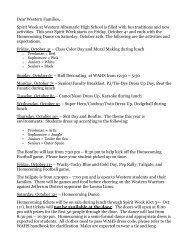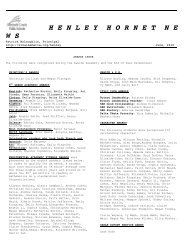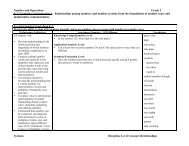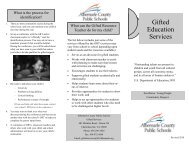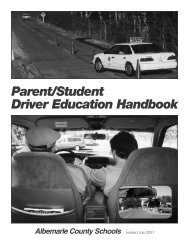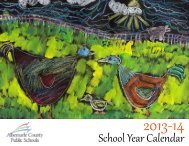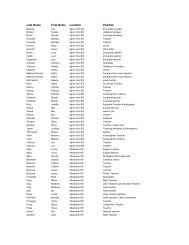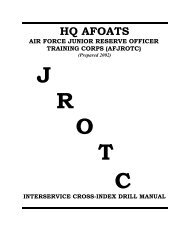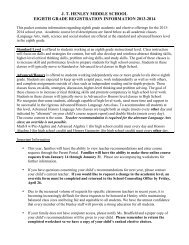Language Arts/English Curriculum Frameworks - Albemarle County ...
Language Arts/English Curriculum Frameworks - Albemarle County ...
Language Arts/English Curriculum Frameworks - Albemarle County ...
You also want an ePaper? Increase the reach of your titles
YUMPU automatically turns print PDFs into web optimized ePapers that Google loves.
on the plot of the book and summarize it to an audience while encouraging other students to read<br />
the book.<br />
• Literature Circle/Book Clubs – Students come together in small groups to discuss a book they have<br />
read. The goal is for the teacher to model and teach children how to lead their own discussion about<br />
a book.<br />
• Retelling/Paraphrasing – Students articulate in their own words what they have read.<br />
• Summarizing – Students tell the important parts of the story.<br />
• Visualizing – Teachers guide students in creating pictures in their minds of what has been read.<br />
• Think-Alouds – The teacher reads aloud to the students and articulates what s/he is thinking about<br />
the reading. This strategy is highly metacognitive and demonstrates to students how good readers<br />
have conversations with themselves about the reading as it progresses, checking for understanding<br />
and making connections. Coaching to help children use the skill independently should follow teacher<br />
demonstrations. (Please see description in 6-12 section for further explanation)<br />
6-12<br />
• Anticipation Guides – An anticipation guide activates students’ prior knowledge and sets a purpose<br />
for reading. The teacher creates a list of statements related to key concepts in a text. The student<br />
decides if s/he agrees or disagrees with the statement. A discussion of students’ responses<br />
proceeds. Students read the text keeping in mind their opinions and the class discussion. After<br />
reading, the students return to the anticipation guide and discuss the statements in light of the<br />
reading.<br />
• Think-Alouds – The teacher models her thought process as she reads. Modeling might include<br />
predictions, confusing points, strategies for clarification, and/or images that come in mind.<br />
© ASPIRE K-12, <strong>Albemarle</strong> <strong>County</strong> Public Schools, 2003<br />
Appendix B<br />
16



